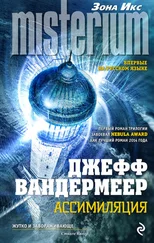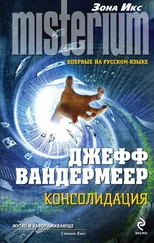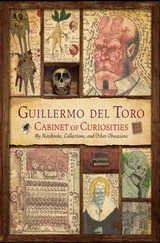Джефф Вандермеер - The Thackery T. Lambshead Cabinet of Curiosities
Здесь есть возможность читать онлайн «Джефф Вандермеер - The Thackery T. Lambshead Cabinet of Curiosities» весь текст электронной книги совершенно бесплатно (целиком полную версию без сокращений). В некоторых случаях можно слушать аудио, скачать через торрент в формате fb2 и присутствует краткое содержание. Жанр: Фэнтези, на английском языке. Описание произведения, (предисловие) а так же отзывы посетителей доступны на портале библиотеки ЛибКат.
- Название:The Thackery T. Lambshead Cabinet of Curiosities
- Автор:
- Жанр:
- Год:неизвестен
- ISBN:нет данных
- Рейтинг книги:5 / 5. Голосов: 1
-
Избранное:Добавить в избранное
- Отзывы:
-
Ваша оценка:
- 100
- 1
- 2
- 3
- 4
- 5
The Thackery T. Lambshead Cabinet of Curiosities: краткое содержание, описание и аннотация
Предлагаем к чтению аннотацию, описание, краткое содержание или предисловие (зависит от того, что написал сам автор книги «The Thackery T. Lambshead Cabinet of Curiosities»). Если вы не нашли необходимую информацию о книге — напишите в комментариях, мы постараемся отыскать её.
The Thackery T. Lambshead Cabinet of Curiosities — читать онлайн бесплатно полную книгу (весь текст) целиком
Ниже представлен текст книги, разбитый по страницам. Система сохранения места последней прочитанной страницы, позволяет с удобством читать онлайн бесплатно книгу «The Thackery T. Lambshead Cabinet of Curiosities», без необходимости каждый раз заново искать на чём Вы остановились. Поставьте закладку, и сможете в любой момент перейти на страницу, на которой закончили чтение.
Интервал:
Закладка:
When they got to the crypt, they found that one of the doors was hanging open—and that was odd, but they didn’t make nothing of it. They thought maybe there’d been an earthquake, a little one that wasn’t much noticed, and the place had gone a little crooked. It happens all the time. But inside the thing, they found the floor all tore up. There used to be marble tiles down there, and now they were gone. Nothing but dirt was left.
I expect they wondered if someone hadn’t gotten inside and stolen them. Marble might’ve been worth something.
They didn’t worry about it much, though. They just dumped old Addison Howell into his slot, scooted the lid over him, and shut the place up behind them. Then they remembered the girl who lived at Howell’s place—nobody knew her name, on account of she’d never said it—and they headed up there to let her know what had happened.
I think privately they thought maybe now she’d come into town and pick a husband, somebody normal and good for her. There weren’t enough women to go around as it was, and she was pretty enough to get a lot of interest.
When they told her the news she started screaming. They dragged her into town to try and calm her down, but she wasn’t having any of it. Around that time there was a doctor passing through, or maybe Humptulips had gotten one of its own. Regardless, this doctor gave her something to make her sleep, trying to settle her. They left her in the back room of the general store, passed out on a cot.
And that night, the town woke up to a terrible commotion coming from the cemetery behind Saint Hubert’s. Everybody jumped out of bed, and people grabbed their guns and their logging axes, and they went running down to the church to see what was happening—and the whole place was just in ruins. The church was on fire, and the cemetery looked like someone had set off a bunch of dynamite all over it. The Howell crypt was just a bunch of rubble, and there was a big old crater where it used to be.
And by the light of the burning church, the mayor and the logging foreman and about a dozen other people all swear by the saints and Jesus, too . . . they saw a big machine with a tall black stack crawling away—and sitting inside it was the demon Addison Howell, driving the thing straight back to hell. Some said he was laughing, some said he was crying. Most everyone said they were glad he was gone.
ENDNOTES
1. Colloquialism for severe poverty. I offered to amend the “i” in “piss” to an asterisk for the sake of decency, but head of antiquities Dr. Meagher said to leave it alone, surprising no one even a little bit.
2. Census records for this region are all but nonexistent until well into the twentieth century, so little is officially known about the town’s population; but anecdotal evidence and extensive, thankless, unpaid legwork by a graduate student (who is poor enough to warrant an analogy in need of an asterisk) suggests that fewer than three hundred people were in residence at the time.
3. Records kept at Saint Hubert’s Church imply an average of half a dozen deaths per year—startling only if one fails to consider that Humptulips was a logging town. As a side note, it turns out that St. Hubert is the patron saint of woodsmen.
4. Mrs. Oberg took this opportunity to speculate with regards to what wild animals might have eaten the girl’s family, and then suggested that maybe she was too traumatized to speak thereafter. She also brought up the possibility that Mr. Howell was a pedophile, though that isn’t the term she used. As Mrs. Oberg went on at great length upon the subject, her digression has been edited out. After all, an endnote is in better taste, unless Dr. Meagher wants a protracted diatribe about body parts and their respective fluids described with a good number of Anglo-Saxon, consonant-heavy words engraved on a plaque right there on the exhibit, surely prompting a number of embarrassed parents 4ato answer many awkward questions on the way back to the car.
4a. Do they still let children scale the Clockroach and pretend it’s a train? That was always my favorite part of school field trips to the SMPI, until one day I fell off and impaled my foot on a rusty spring. They made me get a tetanus shot.
5. When asked precisely how everybody knew this if no one ever visited them, Mrs. Oberg’s ironclad logic went as follows: “If they weren’t up to any mischief, they would’ve just moved to town like civilized people.”
6. This seems rather unlikely.
7. The interviewer considered the wisdom of interrupting to ask if the girl was made of metal, given Mrs. Oberg’s previous statement, but resolved instead to save his breath. After all, he wasn’t getting paid by the word. Or at all.
Clockroach: The Facts
(Fact-checking provided courtesy of Julia Frimpendump, professor emeritus of regional history, University of Washington. Sponsored in part by the West Coast Pioneer Bibliography Project, but not sponsored so extensively that the graduate student who was stuck typing out Dr. Frimpendump’s notes was compensated one red cent for his efforts.)
Though Saint Hubert’s church was, in fact, subjected to a fire in 1889, it did not burn in its entirety, and most of its records were preserved. There is a record of burial for a woman named “Rose M. Howell” on October 2, 1878, lending credence that the story of Addison Howell may hold a grain of truth; but there is no record for Mr. Howell’s death, nor any subsequent burial.
After consulting with an archeo-industrialist in Cincinnati, I have concluded that the peculiar device known locally as “the clockroach” is very likely intended for use in the logging industry. Its forward claws suggest a machine capable of carrying tremendous weight, and the multiple legs imply that it could have traversed difficult terrain while successfully bearing a load.
Based on this information, one could speculate a kinder story for the tragic Addison Howell. It’s reasonable to guess that he might have been a lonely man who adopted an orphaned girl, and in his spare time he devoted himself to tinkering . . . eventually coming up with this peculiar engine that might have revolutionized the industry, had it been adopted and mass-produced. His conversation-turned-argument with the logging foreman may have been some patent dispute, or an altercation over the invention’s worth—there’s no way to know.
The casual record-keeping and insular nature of a tiny homesteader’s town has left us little with which to speculate.
However, the remains of a marble crypt can be found in Saint Hubert’s churchyard. The church’s present minister, Father Frowd, says that it collapsed during an earthquake well before his time—and to the best of his knowledge, it was salvaged for materials.
As for the wagon with the murdered occupants and the sole surviving child, evidence suggests that a family by the name of Sanders left Olympia, Washington, intending to homestead near Humptulips in 1881. This family consisted of a widower Jacob and his brother Daniel, and his brother’s daughter Emily. The small family never reached Humptulips, and no record of their demise or reappearance has ever been found.
In one tantalizing clue located (once again) via Saint Hubert’s, a spinster named “Emily Howell” reportedly passed away in 1931, at the estimated age of sixty. Her age was merely estimated because she never gave it, and she passed away without family members or identification. She was found dead alone in the large home she kept outside the city limits—her cause of death unknown.
But she is buried behind the church, and her tombstone reads simply, EMILY HOWELL, D. 1931. SHE NEVER FORGOT HIM, AND NEVER FORGAVE US.
Sir Ranulph Wykeham-Rackham, GBE, a.k.a. Roboticus the All-Knowing
Интервал:
Закладка:
Похожие книги на «The Thackery T. Lambshead Cabinet of Curiosities»
Представляем Вашему вниманию похожие книги на «The Thackery T. Lambshead Cabinet of Curiosities» списком для выбора. Мы отобрали схожую по названию и смыслу литературу в надежде предоставить читателям больше вариантов отыскать новые, интересные, ещё непрочитанные произведения.
Обсуждение, отзывы о книге «The Thackery T. Lambshead Cabinet of Curiosities» и просто собственные мнения читателей. Оставьте ваши комментарии, напишите, что Вы думаете о произведении, его смысле или главных героях. Укажите что конкретно понравилось, а что нет, и почему Вы так считаете.












